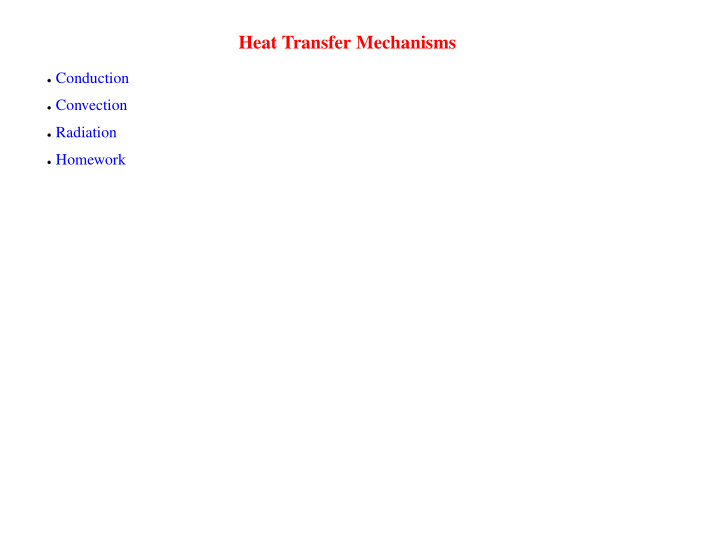



� � � � Heat Transfer Mechanisms Conduction Convection Radiation Homework
� � Conduction Conduction is energy transfer due to an exchange of kinetic energy between molecules – Less energetic molecules gain energy by colliding with more energetic molecules Some substances are good thermal conductors while others are poor – Metals are good conductors because they contain large numbers of electrons that are free to move and transport energy – Materials such as asbestos, cork, and fiber glass are poor conductors – Gases are poor thermal conductors because the molecules are relatively far apart – In general, materials that are good electrical conductors are also good thermal conductors
� ✂ ✁ ☎ ✁ ✂ ✏ ✟ ✂ � ✍ ✍ ☎ ✏ ✍ ☎ ✍ ✏ ✟ ✠ ✎ ✄ ✏ ✏ ✏ ✄ ✁ ✏ ☎ ✑✓ ✁ ✂ ✒ ✄ ✑ ✎ ☎ ✆ ✏ ✝ ✡ ✏ ☎ ✝ ✞ ☎ ✆ ✏ � ✏ ✟ ✠ ✏ Rate of Energy Transfer by Conduction Consider a slab of material of thickness and cross-sectional area with its opposite faces at different temperatures and , where as shown below The rate of energy transfer by heat is ☛✌☞ where has units of watts. For a slab of infinitesimal thickness and temperature difference , we can write the law of conduction as where is the thermal conductivity of the material and is the temperature gradient.
✕ ✔ ✕ ✖ ✖ Example (a) Calculate the rate at which body heat is conducted through the clothing of a skier in a steady-state process, given the following data: the body surface area is 1.80 m and the clothing is 1.00 cm thick; the skin surface temperature is 33.0 C and the outer surface of the clothing is at 1.00 C; the thermal conductivity of the clothing is 0.040 W/m K. (b) How would the answer to (a) change if, after a fall, the skier’s clothes became soaked with water of thermal conductivity 0.600 W/m K?
� � Convection Convection is energy transfer by motion within a fluid An example is the way a room is heated by a radiator – The temperature of the air in contact with the radiator increases – The warm air expands and becomes less dense – Because the warm air is now lighter than the surrounding cooler air, buoyant forces cause it to rise – The surrounding cooler air then flows to take the place of the rising warm air – The warm air sinks as it cools, setting up a continuous air current
✯✰✱ ☎ ✵ ✔ ✖ ✮ ✙ � ✴ ✄ ✙ ✘ ✩ ✳ ✙ ☎ ☎ � ✲ ✄ � ✗✘ ✟ ✪ ☎ ✠ ✴ � ✟ ✠ ✗✘ ✄ ✥ ✟ ✗ ✠ ✛ ✜ ✢ ✢✣ ✢ ✤ Radiation Radiation is energy transfer via the emission of electromagnetic energy The rate at which an object emits energy via thermal radiation is known as Stefan’s law and can be expressed as ☎✚✙ is the power radiated by the object in watts – is called the Stefan-Boltzmann constant ✦★✧ – ✫✭✬ is the surface area of the object – is a constant called the emissivity – is the surface temperature of the body – At the same time that it radiates, an object also absorbs electromagnetic radiation from its envi- ronment The net rate of energy change for the object due to radiation is where is the temperature of the environment
✕ ✕ Example 2 A sphere of radius 0.500 m, temperature 27.0 C, and emissivity 0.850 is located in an environment of temperature 77.0 C. At what rate does the sphere (a) emit and (b) absorb thermal radiation? (c) What is the sphere’s net rate of energy exchange?
� � � Homework Set 7 - Due Fri. Jan. 23 Read Section 17.10 Answer Question 17.21 Do Problems 17.44, 17.48, 17.49 & 17.51
Recommend
More recommend